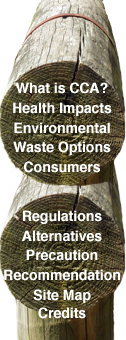Alternatives
Chemical Alternatives
There are several alternative chemicals being promoted as alternatives to CCA, as listed in the table below. None of the available alternatives is a complete substitute on its own for all the uses of CCA and, although they do not involve arsenic or chrome, they still pose environmental and health risks.
Description of Chemical Alternatives to CCA
| ACQ |
CBA |
CDDC |
CC |
LOSP |
|
|---|---|---|---|---|---|
| Full name | Alkaline
copper quaternary |
Copper
boron azole |
Copper
dimethyl-dithiocarbamate |
Copper
citrate |
Liquid
Organic Solvent Preservative, including tri-butyl-tin (TBT)
and permethrin |
| Delivery of treatment | Water-based
solution |
Water-based
solution |
Water-based
solution |
Water-based
solution |
Hydrocarbon
solven |
| Applications | For
all except marine immersion |
For
all except marine immersion and freshwater |
For
above ground applications only |
||
| Impact of copper | More
leaching than CCA- thus higher aquatic toxicity |
More
leaching than CCA- thus higher aquatic toxicity |
Less
leaching than CCA (likely due to being more strongly ‘fixed’) |
More
leaching than CCA- thus higher aquatic toxicity |
|
| Corrosivity | More
corrosive to brass and bronze than CCA |
Same
as CCA |
Same
as CCA |
More
corrosive to brass and bronze than CCA |
|
| Other risks | Leached
most boron |
Leached
most boron |
Hydrocarbon
solvents risky as air and storm-water pollution at treatment
plants; volatile organic compounds make it difficult to work
with |
||
| Benefits | No
leaching of As or Cr; Lower mammalian toxicity than CCA |
No
leaching of As or Cr; Lower mammalian toxicity than CCA |
No
leaching of As or Cr; Lower mammalian toxicity than CCA |
No
leaching of As or Cr; Lower mammalian toxicity than CCA |
|
| Cost | 10-30%
higher than CCA3 |
10-30%
higher than CCA3 |
Higher
than CCA |
Sources: Townsend et al, 2003; Solo-Gabriele et al, 2000; Lebow, 2004; NSW EPA, 2003c.
In addition, many of the alternatives listed in the table cost between 8 and 15 percent more than CCA-treated timber, although it is anticipated that costs will fall if demand rises because of limitations to the use of CCA (NSW EPA, 2003b).
These alternative chemicals employ copper as the main biocide, but also include co-biocides mainly to prevent copper-tolerant fungal decay (Lebow, 2004b). In their evaluation of alternative chemicals, Solo-Gabriele et al (2000) noted that ‘viable non-arsenical waterborne alternatives are available for above ground and ground contact applications’, which accounts for 60% of the treated wood volume. However, little is known of the impact of the co-biocides, and they recommend that their environmental impacts be further evaluated before they are promoted. Townsend et al (2003a) also warn against complete changeover to these chemicals, recommending chemical alternatives to CCA for all situations except those that might ‘impact sensitive aquatic ecosystems’, especially those with limited flushing (Townsend et al, 2003a).
Finally, if CCA-treated timber is to remain in place, the leaching and dislodgement impacts can be reduced temporarily by coating with a stain. Research by Strömberg (2003) found that acrylic coatings and stains provided the longest protection. She also determined that the manual application and drying of this stain was the most important phase in terms of minimizing the resultant environmental impacts. Lebow et al (2003) also determined that paint or pigmented stains provided an effective short term barrier to prevent CCA leaching from the treated timber, noting that clear stains or not sealing the timber quintupled the rate of leaching due to ultra-violet exposure.
References:
Lebow, S., Williams, R. and Lebow, P. (2003), ‘Effect Of Simulated Rainfall And Weathering On Release Of Preservative Elements From CCA Treated Wood’. Environmental Science & Technology 38 (Sept. 15): 4077-4082.
Lebow, S. (2004b), ‘Alternatives to Chromated Copper Arsenate (CCA) for Residential Construction’, Environmental Impacts Of Preservative-Treated Wood Conference, February 8-11, 2004, Orlando, Florida.
NSW EPA (2003b), Environmental Compliance Report- Wood Preservation Industry: Part B: Review of Best Practice and Regulation, NSW Environment Protection Authority, June)
NSW EPA (2003c), ‘Questions and answers on the wood preservation industry’, NSW Environmental Protection Authority website, http://www.environment.nsw.gov.au/licensing/qaswood.htm (accessed 1/11/04).
Solo-Gabriele, H., Kormienko, M., Gary, K., Townsend, T., Tolaymat, T. (2000), Alternative Chemicals and Improved Disposal-End Management Practices for CCA-treated Wood, Florida Center For Solid And Hazardous Waste Management, Florida.
Strömberg, L. (2003), ‘Minimisation Of The Environmental Impacts Of Coatings On Exterior Wood By Optimisation Of Their Life Spans’, International Research Group On Wood Preservation 34, Brisbane, May.
Townsend, T., Stook, K., Ward, M., Solo-Gabrielle, H. (2003) ‘Leaching And Toxicity Of CCA-Treated And Alternative-Treated Wood Products’, Florida Center For Solid And Hazardous Waste Management, Report #02-4


